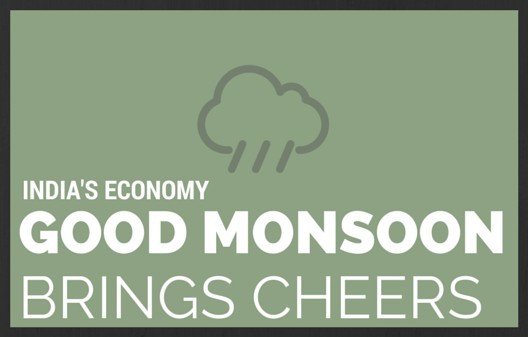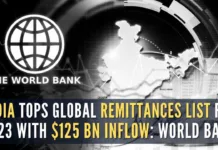
PerformanceGurus Staff
New Delhi
The Monsoon maybe late but there is lots of it… With the monsoon being generous so far, the policy makers in India are hoping for a boost to the rural economy and further decline in inflation, which could pave the way for an interest rate cut and revival of the economy in a big way.
The benevolence of the Rain god has already been lapped up by the stock market, which has shown a steady rise after sliding by almost 10% on forecast of deficient monsoon in early June. Such has been the impact of surplus rain in June that the market has taken in its stride even the Greek tragedy.
According to the Indian meteorological department (IMD), in the month of June, India received nearly 28% more rainfall than normal. India receives three fourth of its annual rain between June and September.
A good monsoon is vital for India to take its Gross Domestic Product (GDP) above 8% and get the required elbow room for taking further economic reforms. Agriculture contributes almost 14% to the GDP and provided employment to millions of people. By boosting rural demand, it also acts as a catalyst for industrial production. Nearly 70% of the rural households depend on agriculture as their main source of livelihood. In addition, agriculture also forms a major part of the export basket.
There are two items of good news on the agriculture front:
The total area sown under kharif crops till July 3 was 57.5% more than last year over 30.60 million hectares (ha). According to the data of the agriculture ministry, farmers have planted five times more oilseeds (2.8 million tons) and two fold more pulses compared to the previous years due to generous rains in Gujarat and Madhya Pradesh. Similarly, in North India surplus rains has led to better sowing of summer crops like rice.
- According to the Central Water Commission, the water storage across 91 reservoirs was estimated at around 43 billion cubic meters by the end of June. This is 11% higher than the previous year and 46% more than the benchmark 10-year average of 29.70 billion cubic meters,
- The better rains scenario has come as big relief for the Government. Finance minister Arun Jaitley on July 12 said that better monsoon would help check food inflation, including in pulses.
“It appears that the rain gods may be kinder this year to us than they were last year,” Jaitley said.He said that the Department of Agriculture expects a better rainfall in most parts of the country to result in higher production of oil seeds and pulses, which at the moment are a cause of concern in terms of inflation.
“I hope their estimates turn out to be true,” Jaitley said, adding that he hoped that the monsoon should keep its pace in the days ahead also.
However, this is where, the forecasters are worried. The IMD data has shown that the progress of the monsoon had slowed down during the week ending July 8.
The IMD data showed that between July 2 and July 8, India received around 30.1 millimeters of rainfall as against a normal 61.4 millimeters.
Central Indian states such as Madhya Pradesh, Maharashtra and Gujarat, and South Indian states of Tamil Nadu, Kerala and Karnataka received less than normal rain during this period. .
The IMD expects that the pave of monsoon and distribution of rain will be slow and sporadic from the third week of July onward.
However, in its latest bulletin private weather forecaster Skymet has said that the Western Disturbance over Jammu and Kashmir will continue affecting the hilly states of North India. Heavy to moderate showers will continue over Jammu and Kashmir, Himachal Pradesh and Uttarakhand. Rain will gradually reduce from Mondayonwards.
Monsoon trough is extending from North Rajasthan up to the Bay of Bengal across the depression over Central India. Rain will continue all along the trough line.
This depression over Central India is moving in the northwest direction. But the upper air trough, extending from the hills of North India to South Pakistan, seems to be restricting the fast movement of the depression. Consequently, the depression will remain stationary over West Madhya Pradesh and adjoining Rajasthan for some time. It will bring heavy showers over West Madhya Pradesh, adjoining Rajasthan and Southwest Uttar Pradesh.
Monsoon showers seem to be gaining strength in Northeast India, especially Assam and Arunachal Pradesh. Sub Himalayan West Bengal will also receive good showers tomorrow.
While farmers and policymakers will keep their fingers crossed, it is clear that so far monsoon has not disappointed India. if it does not slow down in the coming weeks, the stock market is set to rocket in the days ahead since micro data are also turning positive, slowly and steadily.
- Supreme Court rejects plea to tally all VVPAT slips with EVM votes; says ‘no going back to paper ballot’ - April 26, 2024
- US report citing human rights violations is deeply biased: India - April 25, 2024
- Kotak Mahindra Bank shares tank 13%. Market Cap erodes by Rs.37,721 cr post-RBI action - April 25, 2024










